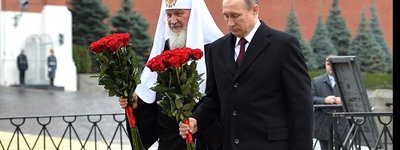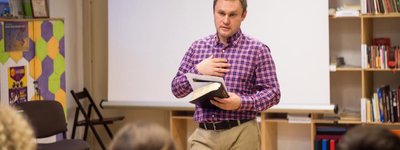The Secret Library
One hot, sunny day last month in Lviv a friend told me excitedly that I was about to witness an historic event. I followed him to Saints Peter and Paul, the old Jesuit church on Teatral'na Street in the city's historic center. Designed by the Italian architect Giacopo Briano, the church was begun in 1610 and, like most Jesuit churches throughout the world, was modeled on Rome's Gesú, built some thirty-five years earlier. After the annexation of Eastern Galicia to the USSR during World War II, it was closed.
But now it was open. We entered. The dim naves were stacked high with innumerable books, carefully labeled and arranged neatly on shelves. These were old tomes, confiscated decades ago by the Soviet authorities from various private collections. Seen against the background of the heavenly Baroque frescoes, sculptures and decorations, the bookshelves reminded one of Jose Luis Borges' vision of Paradise as a kind of library.
One could not help being struck by a compelling symbolism: the Church as a repository of knowledge. And a Jesuit church at that! Initiated by St. Ignatius Loyola in the 1530s, the Society of Jesus gained papal recognition in 1540. It soon became famous for its network of schools, part of the massive and multifarious Catholic response to the Protestant Reformation. In seventeenth-century Ukraine, Jesuit schools were founded in Kyiv, Luts'k, Kamianets'-Podil'skyi and other cities, as well as in L'viv. In fact, the Cossack chief Bohdan Khmel'nyts'kyi was educated in the college adjoining this very church. Another Cossack leader and patron of the Orthodox Church, Ivan Mazepa, studied at the Jesuit college in Warsaw. Orthodox Metropolitan Petro Mohyla, who advocated Latin-based Western learning (a controversial attitude opposed by some Moscow-oriented clergy and Cossacks), followed the Jesuit educational model when he founded the Kyivan school that eventually became the Academy which bears his name today. It was thus appropriate that this Jesuit church should have served to preserve a vast body of printed knowledge during the dark night of the Soviet "enlighteners."
Of course, nothing could have been farther from their minds. They regularly used churches as warehouses – and also as stables, cinemas, and social clubs. The Jesuit church must have seemed a handy place to store a mass of confiscated books that might contain the kinds of ideas that they preferred to keep under wraps. After all, the Soviet Union printed plenty of its own books – not only the works of Soviet authors, of course, but also the carefully edited and censored works of both Ukrainian and Western writers. On the other hand, these confiscated volumes might have some value. So they kept them hidden in a closed church.
In this way, the Soviet authorities illustrated their policy towards the Church as an institution. For by sealing it off from society, they sought to prevent ideas and information from either leaving or entering. The Church would no longer affect the way people thought, and it would no longer be affected by knowledge from the outside world. It would die from intellectual asphyxiation. As a result, two generations of Ukrainians grew up without any religious education, while the underground Church received only the barest notions about, for example, the Second Vatican Council.
In this way, the authorities forced the Church to conform to their image of it as a closed system, unreceptive to the world and indifferent to society. Such a system, divorced from life itself, would surely perish. And what better way to represent this antiquated institution than by housing a mass of out-of-date literature in a sealed church building?
But neither the Catholic Church and its teaching, nor the Jesuit church and its library, ended up in the dustbin of history. Soon, we are told, the books will be transported to a more appropriate storage area. As state property, they will presumably be made available to the public. The historic building itself is finally open to the public, now as a Ukrainian Greek-Catholic church. Far from serving to suppress knowledge, the Church has served to preserve it for posterity.










